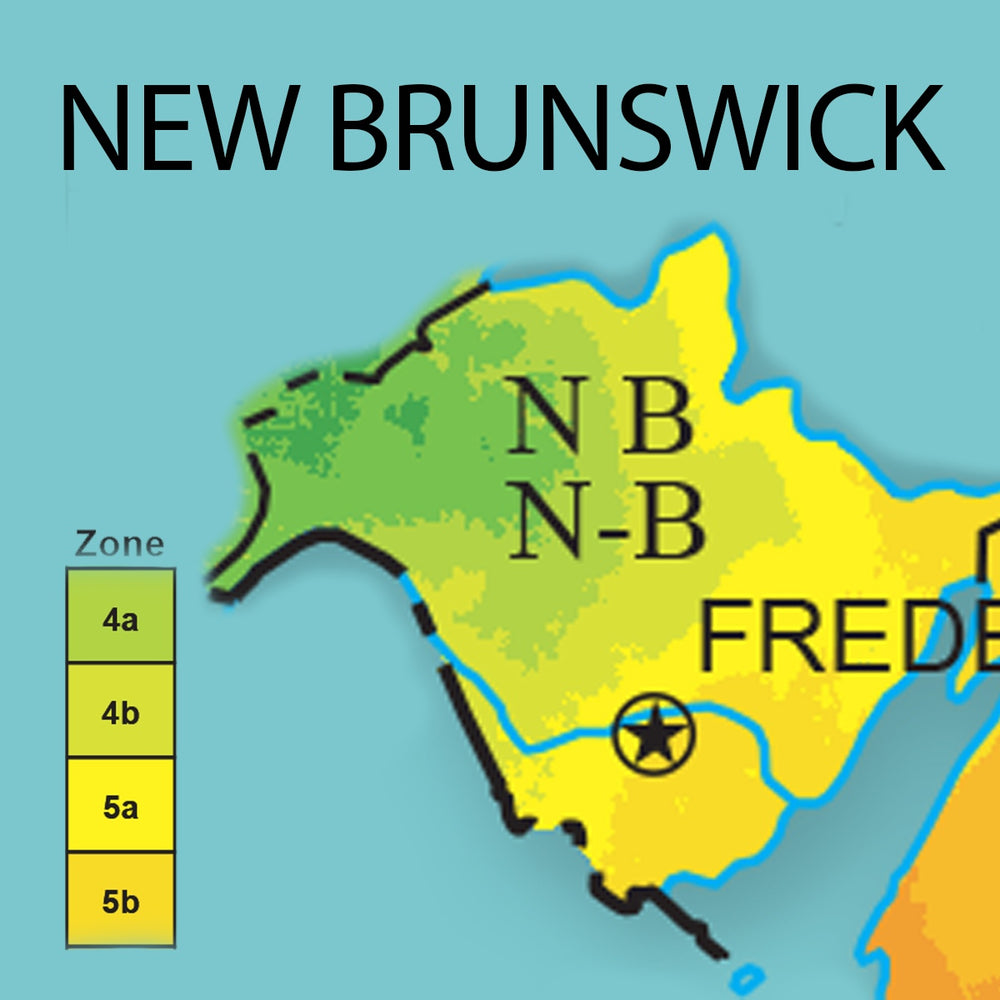Image from Natural Resources Canada
Characteristics of New Brunswick Planting Region
The climate of New Brunswick is continental and is characterized by freezing, snowy winters and warm, humid summers. The province experiences plenty of rainfall throughout the year, with some level of precipitation even in the driest months.
Most areas will also experience a range of severe weather conditions such as:
- Floods
- Torrential rain
- Tornadoes
- Abundant snowfall
- Strong winds
-
Snowstorms
Additionally, the growing season generally lasts about 125 days between May and September; however, it’s always best to check the specific frost dates for your area.

Challenges of Growing in New Brunswick
1. Flooding
Unfortunately, New Brunswick is prone to flooding due to rapid snowmelt, heavy rainfall, and high tides. To keep your garden safe, it’s suggested to utilize raised garden beds and an indoor or protected growing environment.
2. Short Growing Season
The planting season is short and mild throughout the province. Brief growing timeframes coupled with moderate temperatures mean many gardeners should opt for an element of indoor gardening to maximize the growing period.
3. Abundant Snowfall
Heavy snowfall can be expected throughout New Brunswick, limiting opportunities for gardeners to extend their growing season into the winter months. As a solution, indoor gardening or protective coverings are recommended to keep your plants alive and healthy as the seasons get colder.

The Benefits of Using a Greenhouse in New Brunswick
A greenhouse is a wonderful solution for those wishing to extend their planting season in New Brunswick. Not only will it protect your garden from early frosts, heavy snowfall, and cold temperatures, but it can also help keep your plants safe from flooding in this region. By utilizing raised garden beds and a sturdy greenhouse base, gardeners will be able to keep their plants out of harm’s way in this region.
1. Extend your Growing Season
-
Without a Greenhouse:
The standard growing season in New Brunswick ranges between 3-4 months each year. However, for outdoor gardeners, the relatively short planting season and mild temperature conditions create a variety of challenges. To mature in time for the first frost of the season, many plants will require some element of indoor growing.
-
With a Greenhouse:
Greenhouse gardeners can expect an extended growing season of 6-8 months and potentially year-round if using heaters and other accessories. In addition, gardeners in New Brunswick will be able to experiment with a variety of warm-weather and longer-season vegetables that would typically struggle to grow to maturity in an outdoor setting.
Learn more about specific growing dates for your area and the best vegetables to plant in each part of New Brunswick.


2. Grow a Wider Variety of Vegetables
-
Without a Greenhouse:
The short growing season, mild summers, and heavy precipitation mean outdoor gardeners should focus on cool-hardy and short-season plants to avoid disappointment. Some of the vegetables suggested for the New Brunswick climate include:
- Broccoli
- Cauliflower
- Cabbage
- Turnips
- Radishes
- Arugula
- Spinach
-
Lettuce
-
With a Greenhouse:
Gardeners will be able to increase the length of their growing season and explore a wider variety of plants with a Planta greenhouse. Some of the vegetables that have been known to thrive in a greenhouse in this area include:
- Tomatoes
- Peppers
- Eggplants
- Beans
- Cowpeas
- Corn
- Squash
- Pumpkins
- Cucumbers
- Watermelon
- Gourds
- Asparagus
- Brussel Sprouts
- Mustard
- Onions
- Sweet Potatoes
- Cantaloupes
- Carrots
- Green Onions
- Leeks
- Mint
-
Zucchini

Why Planta Greenhouses?
- Wind resistant up to 65 mph (learn more about how our greenhouses hold up in high-altitude climates).
- Withstands a snow load of up to 98 psf (480kg/square meter).
- Made with a heavy-duty galvanized steel frame.
- Polycarbonate panels provide 100% protection against UV rays.
- The Sungrow greenhouse is bell-shaped - allows the wind, snow, and hail to slide off the sides.
- Extendable (Sungrow, Sigma and Farmer models can be extended beyond 100ft)
- Made in Europe and are exclusively imported
- Maintenance-free

